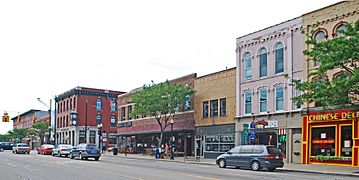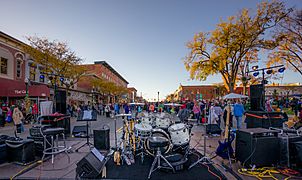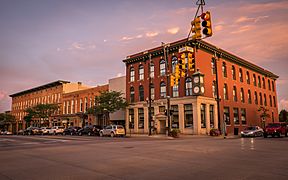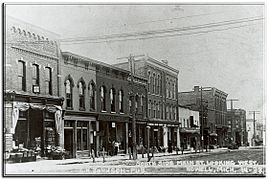Howell Downtown Historic District facts for kids
Quick facts for kids |
|
|
Howell Downtown Historic District
|
|
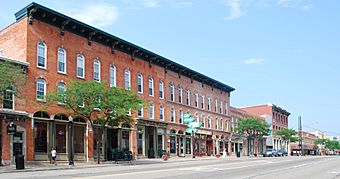
Grand River at State, Looking west
|
|
| Location | Roughly bounded by Clinton, Barnard, Sibley, and Chestnut Sts., Howell, Michigan |
|---|---|
| Area | 17 acres (6.9 ha) |
| Architect | Almon Clother Varney, Sidney Badgley, et al. |
| Architectural style | Mixed (more Than 2 Styles From Different Periods), Italianate |
| NRHP reference No. | 86003363 |
| Added to NRHP | February 27, 1987 |
The Howell Downtown Historic District is a special area in the heart of Howell, Michigan. It's like a time capsule, showing off many old and important buildings along five blocks of Grand River Avenue. This district was added to the National Register of Historic Places in 1987 because of its historical importance.
A Glimpse into Howell's Past
Howell first became a settlement around 1833-1834. A few years later, in 1836, it was chosen as the main town, or "county seat," for Livingston County. This meant it became an important place for local government and business.
The area along Grand River Avenue has been the busy center of Howell since the 1830s. The buildings you see there today mostly date back to the 1870s. There were big fires in 1887 and 1892 that destroyed some of the older buildings. But people quickly rebuilt, putting up new structures in their place.
Exploring the Historic District
The Howell Downtown Historic District is right in the middle of the city's main business area. It covers about fourteen acres and includes parts of nine city blocks, plus the area around the courthouse. There are sixty buildings in the district, and forty-six of them are considered important to its history.
These buildings were built between 1865 and the mid-1900s. They show off many different building styles, like Italianate, Gothic Revival, High Victorian, Richardsonian Romanesque, Neoclassical, Tudor Revival, Colonial Revival, and Art Deco. Most of the buildings are one or two stories tall and were used for shops and businesses. The district also includes important public buildings like the Livingston County Courthouse, the Carnegie Library, and the First Presbyterian Church.
Cool Buildings to See
Here are some of the interesting buildings you can find in the district:
- First Presbyterian Church (323 West Grand River Avenue): This church was designed in 1915 in a style similar to old English Gothic churches. It's made of gray stone and has a tall, square tower with pointed decorations and an arched bell tower. The windows have fancy Gothic designs.
- Carnegie Library (314 West Grand River Avenue): Located across from the church, this library was built between 1903 and 1906. It has a classic Neoclassical style and is made of local fieldstone and granite in shades of gray, deep rose, and white. A round dome sits on top of its roof.
- McPherson Oil Company (223 West Grand River): This old building has a large brick chimney on the outside and features of the Tudor Revival style, which looks a bit like old English countryside homes.
- Opera House (123 West Grand River Avenue): This three-story red brick building was built in 1881. The first floor had shops, and the top two floors held a theater where people could watch shows. In 1938, a shiny black glass storefront was added.
- McPherson Store (108-110 West Grand River): This two-story building is made of different colored bricks and decorated with colorful tiles. It has a heavy roof edge with small towers and arched windows on the second floor with flower designs. It was built for a blacksmith and merchant named William P. McPherson, probably in the 1880s.
- Jewett Block (101 East Grand River): Now home to the First National Bank, this three-story brick building was built in 1872-1873. It has arched windows and a heavy, decorated roof edge, typical of the Italianate style. It was first built for dry goods merchants.
- Livingston County Courthouse (200 East Grand River Avenue): This large, three-story building was designed in 1889. It's set back from the street on its own block. It has a very noticeable clock tower that can be seen from far away, sitting on a steep roof with dormer windows.
- Howell Theater (313-319 East Grand River Avenue): This two-story yellow brick building was built in 1912 as the Temple Theater. The cool, modern-looking Art Deco sign and entrance were added later.
Gallery


